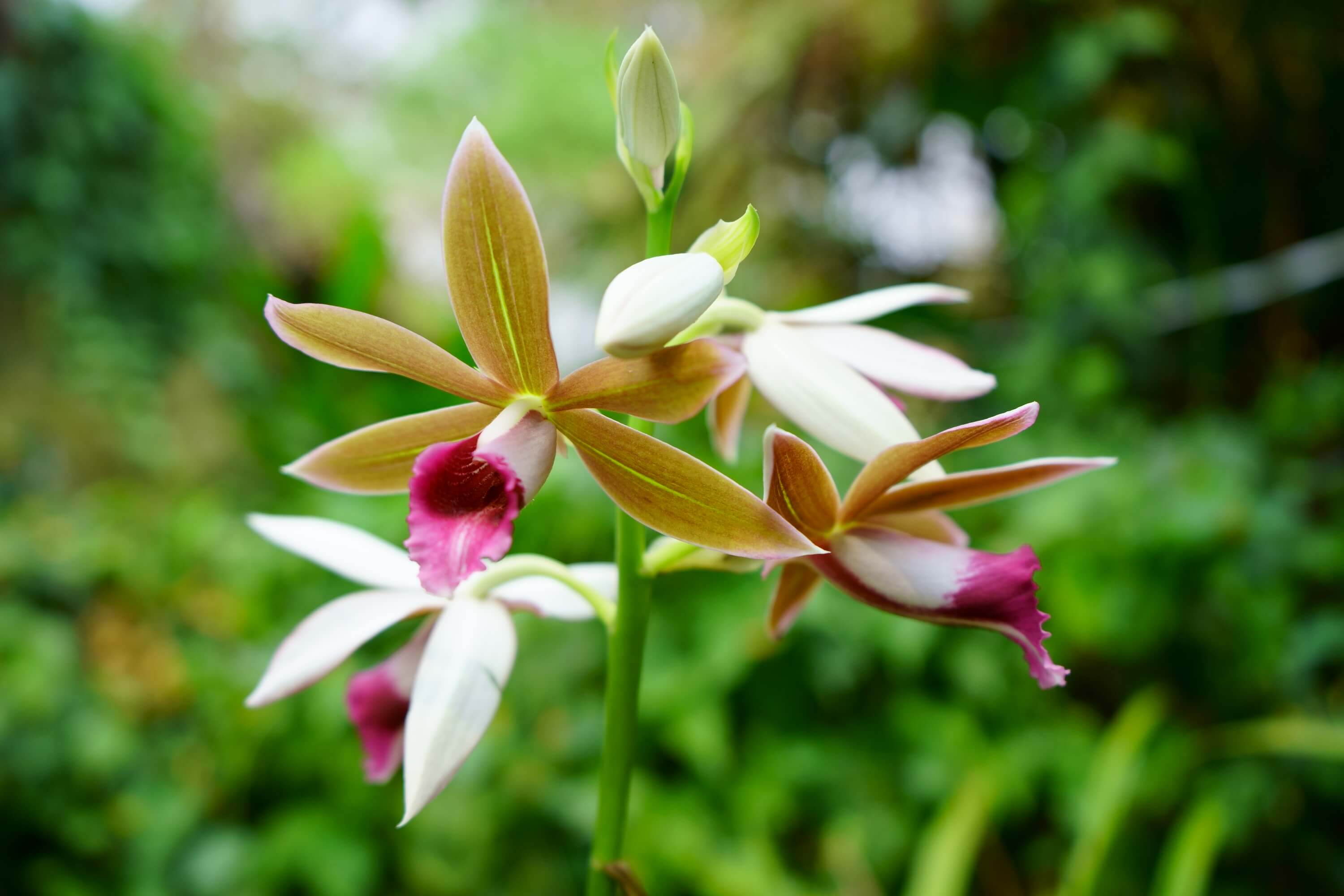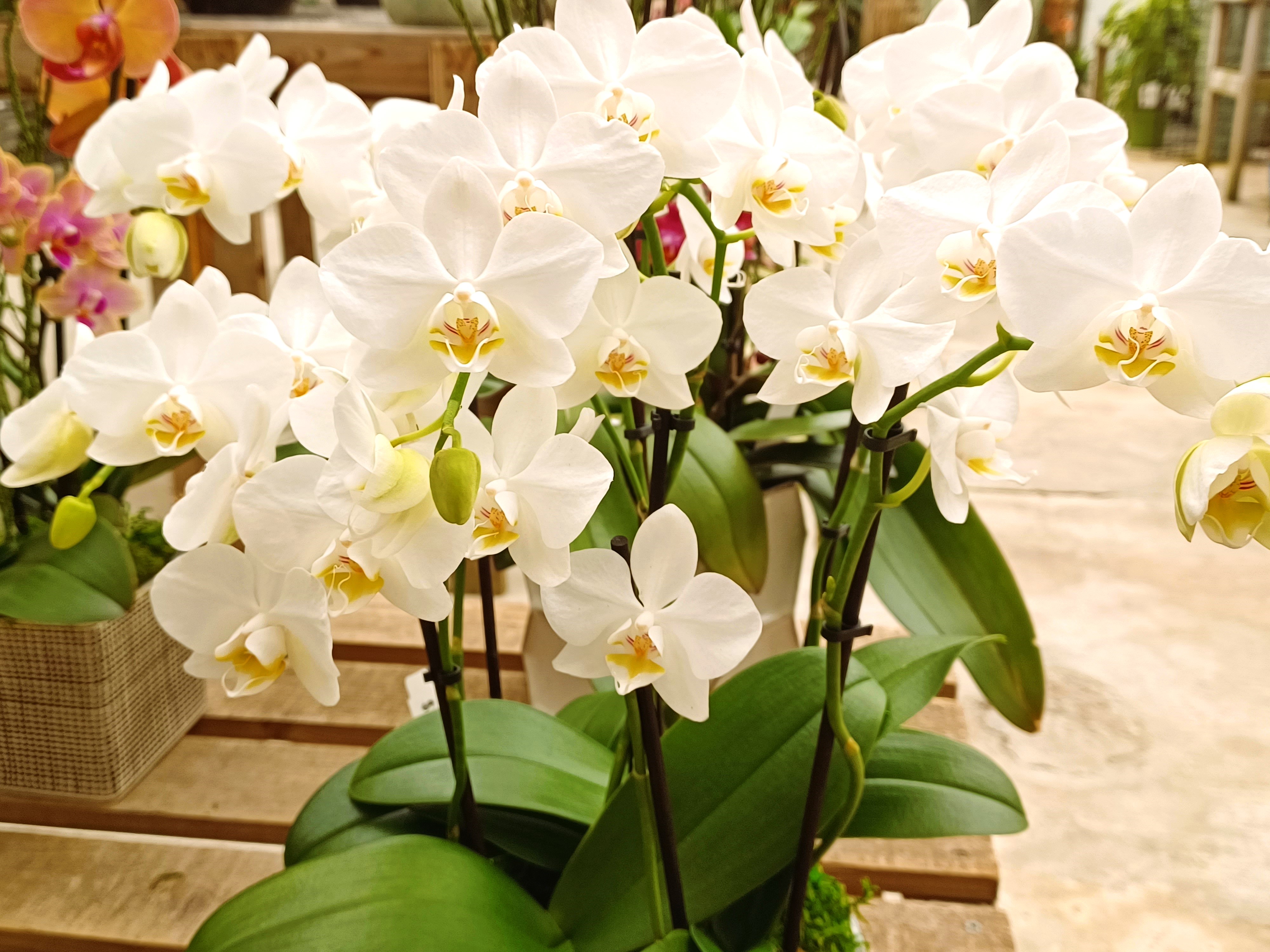Orchid Care After Flowering: How to Keep Your Orchid Thriving
It’s always bittersweet when the last bloom falls from your orchid—after weeks or even months of stunning flowers, your plant enters its next phase of growth. But don’t worry! With the right orchid care after flowering, you can encourage new blooms, maintain plant health, and even propagate new orchids. Whether you have a Phalaenopsis, Vanda, Dendrobium, Cattleya, Oncidium, or Paphiopedilum, these steps will help your orchid thrive.

We are an Affiliate! We hope you find this information useful. Just so you know, we may collect a share of sales or other compensation from the links on this page. Thank you if you use our links, we really appreciate it.
Grow Thriving Orchids! Sign Up for Exclusive Care Tips & Tricks!
What to Do with the Flower Spike After Blooming
Once all the flowers have dropped, the first question many orchid owners have is: Should I cut the flower spike? The answer depends on the type of orchid you have.
- Phalaenopsis (Moth Orchids): These popular orchids may rebloom from the same spike. Trim ½ inch above a healthy node to encourage a secondary spike or keiki.
- Dendrobiums: Some varieties (like Den. nobile) bloom on old canes, while others (like Dendrobium/ Phalaenopsis hybrid types) produce new spikes annually. Cut back only dead or yellowing stems.
- Cattleyas: These orchids bloom once per spike. Once flowers fade, cut the spike at its base.
- Oncidiums (Dancing Lady Orchids): Remove the entire spike after flowering, as they won’t rebloom from the same stem.
- Paphiopedilums (Lady Slipper Orchids): These single-growth orchids should have their flower stems cut at the base after blooming.
According to the American Orchid Society (AOS), proper post-bloom pruning helps direct energy toward new growth rather than sustaining old spikes. Using the right tools makes orchid pruning safer and more effective. A quality pair of sterilized pruning shears helps prevent infection while giving you clean cuts for healthier plants.

- Professional-grade pruners - Swiss-made precision tools
- Premium steel blades – Clean, precise cuts
- Replaceable parts – Lifetime guarantee included
- Ergonomic grip – Comfortable for all-day use
- Wire-cutting notch – Versatile garden tool
- Shock absorbers – Reduces hand fatigue
- Non-slip coating – Secure handling guaranteed
How to Prune for Reblooming (Phalaenopsis Technique)
To stimulate a new flower spike or keiki in Phalaenopsis orchids:
- Locate a healthy node – Find the lowest node where the first flower appeared.
- Make a clean cut – Using sterilized pruning shears, trim about ½ inch above the node at a 45-degree angle.
- Prevent infection – Dust the cut with cinnamon (a natural antifungal).
Over the next few weeks, watch for new growth. If a secondary spike emerges, you may get another round of blooms. If a keiki forms, you’ll have a whole new orchid to nurture!
Pro Tip: Keep your orchid in bright, indirect light and maintain proper humidity. A small humidifier nearby can help mimic the orchid’s natural tropical environment. For orchid collections or larger growing spaces, a high-capacity humidifier like the Dreo 6L Capacity Humidifier ensures optimal humidity levels with precision control—allowing you to customize conditions for both moisture-loving Vandas and air-mount orchids alike.

Repotting: A Key Step in Orchid Care After Flowering
The AOS recommends repotting most orchids every 1-2 years, as the potting medium breaks down over time. Post-blooming is the ideal time to repot, as the plant isn’t directing energy toward flowers.
Orchid-Specific Repotting Tips
- Phalaenopsis: These popular orchids do best in medium-grade orchid bark mix that retains some moisture while allowing air flow. Repot when you see new root tips emerging, typically after flowering. The American Orchid Society recommends using a mix of sphagnum moss and bark for optimal moisture control in drier climates.
- Vandas: These epiphytic orchids often grow bare-rooted or in coarse bark. If potted, use very chunky medium for airflow.
- Cattleyas: Repot when new roots appear (usually after flowering). They thrive in fir bark or lava rock mixes.
- Dendrobiums: Some types (like hard-cane Dens) prefer to be slightly root-bound, while soft-cane varieties need more frequent repotting.
- Paphiopedilums: Use a fine, moisture-retentive mix (like sphagnum with perlite).
Discover the perfect growing medium for your orchid! Our expert guide to the best orchid bark breaks down ideal mixes for every variety - from moisture-loving Phals to air-hungry Vandas

- rePotme Orchid Potting Mix
- Phalaenopsis AAA Gold Imperial Orchid Mix (Mini Bag) -
- Premier Orchid Potting Mix with Orchid Moss and Orchid Bark -
- Hand Blended in The USA
Step-by-Step Repotting Guide
- Remove the orchid from its pot – Gently take it out and shake off the old potting mix.
- Inspect and prune the roots – Healthy roots are firm and green/silver. Trim any brown, mushy, or dead roots with sterilized scissors.
- Clean the plant – Rinse the roots to remove debris and check for pests.
- Choose the right potting medium – Match the original mix unless you’re experienced with alternatives like LECA or mounted culture.
- Repot in a slightly larger container – Orchids prefer breathable pots with drainage.
After repotting, consider your orchid’s environmental needs—many varieties thrive with increased humidity. A garden waterfall not only elevates your display but creates a microclimate of moisture, reducing the need for frequent misting. Perfect for grouping with moisture-loving orchids like Paphiopedilums or Masdevallias

- 50" rustic fountain with LED lights and cascading water.
- Lightweight resin and stone construction, easy to move.
- Includes water pump, 3 LED bulbs, and 6-foot cord.
- Perfect for gardens, patios, balconies, or indoor spaces.
- Creates soothing ambiance with 4-tiered water flow design.
Alternative Orchid Growing Methods
Once you've mastered traditional potting, consider these innovative cultivation techniques to expand your orchid-growing experience:
- Full Water Culture (FWC): Some growers successfully sustain orchids with roots permanently submerged in water. This method requires careful monitoring to prevent rot. Explore our Ultimate Guide to Full Water Culture for step-by-step instructions.
- Semi-Hydroponics: Using LECA (clay pellets) in self-watering pots creates consistent moisture while preventing soggy roots—ideal for Phalaenopsis and Cattleyas.
- Air Mounting: Epiphytic orchids like Vandas thrive when mounted on cork boards, vertical planter frames or tree fern plaques, mimicking their natural habitat. Mist daily or soak weekly.
- Hanging Baskets: Vandas are the classic choice for bare root hanging culture, with their spectacular aerial roots and tall growth habit. Their need for daily watering/soaking and bright light makes open baskets ideal. Some pendant-growing Dendrobiums (like Den. anosmum or Den. parishii) also adapt well to slatted baskets when their long canes naturally arch downward.
- Terrariums: Miniature orchids (e.g., Masdevallias) flourish in high-humidity glass enclosures with sphagnum moss.
Your original potting medium can evolve as you experiment. Many enthusiasts combine methods—for example, mounting a Cattleya on cork while using a humidity tray beneath it. Read more about how LECA is used in self-watering systems.
Orchid Repotting Essentials:
- Orchid potting mix (bark, sphagnum moss, or specialized blends)
- Sterilized pruning shears
- Cinnamon powder (for disinfecting cuts)
- Clear plastic pots (to monitor root health)
Ongoing Orchid Care for Future Blooms
Different orchids have varying needs, but general care includes:
Light Requirements:
- Low to Bright Shade: Phalaenopsis, Miltoniopsis, Masdevallias, and some Paphiopedilums.
- Bright Indirect Light: Brassias, Cattleyas, Miltonias, and Oncidiums.
- Very Bright Light: Brassavolas, some Cattleyas, and Vanda orchids.
Watering:
- Vandas: Daily misting or soaking (if bare-rooted).
- Cattleyas, Dendrobiums: Let dry slightly between waterings.
- Paphiopedilums: Keep evenly moist (never soggy)
For specific orchid care requirements read our Ultimate Guide on How to Water Orchids.
Fertilizer:
- Use a balanced orchid fertilizer (20-20-20) diluted to half strength.
- Many Orchid Growers prefer MSU Orchid Fertilizer.
- Tailored for Orchids Specifically formulated by Michigan State University
- Pure Water Compatibility
- Balanced Nutrient Profile
- Urea-Free Formula
- Versatile and Easy to Use
Humidity:
- Most orchids prefer 40-70% humidity.
Styling Your Orchid Display
While waiting for the next bloom, showcase your orchid as part of your indoor garden decor:
- Vandas: Hang in wooden baskets for a dramatic look.
- Cattleyas: Place in ceramic pots for a classic touch.
- Miniature orchids (like some Dendrobiums): Display in glass terrariums.
Orchid Decor Ideas:
- Modern ceramic pots
- Hanging mounts (for Vandas or mounted Phalaenopsis)
- Orchid display stands
Disclosure: We earn a commission if you purchase through this link.
Continue Proper Orchid Care After Flowering
Proper orchid care after flowering ensures healthy plants and and in a few months, your orchid will start to produce a new flower spike. By pruning correctly, repotting when needed, and providing species-appropriate care, you’ll enjoy stunning flowers year after year.
Follow us on Pinterest for more expert advice, or sign up for our orchid care newsletter!
We hope you found this information useful and if you like Heavenly Orchids, please join our mailing list for monthly updates.
Follow Us On Pinterest for expert orchid care after flowering tips, stylish display ideas, and seasonal growing guides! Join our community of orchid lovers where we share:
- Step-by-step tutorials for repotting and propagation
- Trending terrarium designs for miniature orchids
- DIY mounting techniques for air plants and Vandas
- How to grow orchids in water culture












